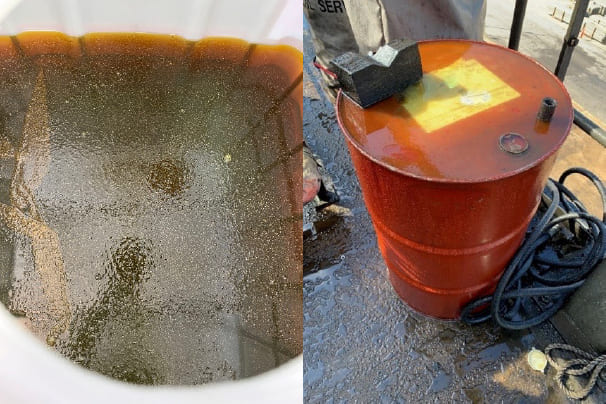Why Scheduled Oil Changes Aren’t Enough to Mitigate Lubricant Contamination
 There are few problems more insidious or damaging to large industrial machinery than contaminated lubricant. Potential consequences run the gamut, from subtle issues like increased operating temperature, to more severe issues like machine frothing, total machine failure or permanent structural damage to the equipment. In “System Approach to Contamination Control,” Vickers, Inc., found that “proper selection and placement of contamination control devices… eliminates (the root cause of) up to 80% of hydraulic system failures.”
There are few problems more insidious or damaging to large industrial machinery than contaminated lubricant. Potential consequences run the gamut, from subtle issues like increased operating temperature, to more severe issues like machine frothing, total machine failure or permanent structural damage to the equipment. In “System Approach to Contamination Control,” Vickers, Inc., found that “proper selection and placement of contamination control devices… eliminates (the root cause of) up to 80% of hydraulic system failures.”
In fact, Bearing Maintenance Handbook, SKF, states that proper lubrication and ideal conditions could theoretically result in “infinite life” for bearings, meaning that the sky is the limit in the potential benefits of lubricant improvement. And aside from the obvious lost uptime, this can also result in expensive product integrity investigations to rigorously stress-test the entire workflow.
One factor exacerbating the problem is that early signs of lubricant contamination are so subtle and diverse that they’re often overlooked by hardworking crews. But even if these issues never culminate in the worst-case scenario, the aggregate wear and loss of efficiency over an extended period — and spread across a fleet of machines — can still result in a massive impact on revenue and production scheduling.
 While regularly scheduled lubricant-replacement routines are the standard solution to this challenge, modern innovations have made it possible to achieve higher levels of efficiency, reliability and cost-effectiveness with an oil-analysis routine. Such a routine is more adaptive to the specifics of your project and can save compounding amounts of time and money by extending uptime and reducing maintenance costs throughout your equipment.
While regularly scheduled lubricant-replacement routines are the standard solution to this challenge, modern innovations have made it possible to achieve higher levels of efficiency, reliability and cost-effectiveness with an oil-analysis routine. Such a routine is more adaptive to the specifics of your project and can save compounding amounts of time and money by extending uptime and reducing maintenance costs throughout your equipment.
Causes of Lubricant Contamination
Lubricant contamination comes in so many forms and from so many different sources that it’s nearly impossible to anticipate them all. Some of the most common sources are water, heat, air, solid particles and other lubricants. This can be due to the environmental conditions, improper storage and handling procedures, as well as human error.
 Impacts of contamination could include:
Impacts of contamination could include:
- Temperature – Stuck LO temp. control valve
- Aeration – Excess silicon from other oils or aftermarket foam additives can increase air release, which can cause pump failure and other operational issues.
- Foam can result from excessive airborne contaminants that can cause poor level indication, along with potential sump overflow.
- Elevated system pressures due to sticking pressure-relief valve
- Restriction in pump suction
- Leakage due to excessive seal wear
Since these problems are recurrent and compounding, they can be easily corrected once identified. However, with routine scheduled oil changes, those problems won’t be identified until the company experiences a shorter-than-expected lifecycle for their equipment that can be subject to costly repairs or replacement.
Challenges of Determining if Your Oil Is Contaminated
The most dangerous part of lubricant contamination is how easily it’s overlooked. While most oil analysis reports can detect the problem and alert users through notifications, those notifications are often vague and indicative of more serious problems. Other signs, like running hot, excessive vibration and maintaining elevated reservoir temperatures, are easily overlooked as products of the working environment.
The excessive wear, particularly on bearings, that can result from certain types of contamination can even be invisible until it’s too late and the damage requires unscheduled maintenance or even renders the machine inoperable.
Normal Procedures for Preventing Oil Contamination
The traditional method for preventing oil contamination observed by most industrial teams is a scheduled system by which, after a set number of hours of uptime, the machine’s oil is drained and appropriate filters are replaced. This system generally prioritizes critical machinery, rotating through them to make sure that the process can continue at an appropriate pace. The advantages to this system are mostly due to its simplicity: teams can predict exactly when the machines will need maintenance and schedule accordingly.
The main disadvantage of routine oil-replacement scheduling is that it allows undetected contamination problems to exacerbate the wear and tear on the machinery. This can potentially causinge a minor error to grow into a costly and time-consuming maintenance issue that can disrupt profits and cause missed deadlines. It can also introduce a greater potential for human error, as early warning signs of more serious problems can be overlooked.
Advantages of Analysis
In contrast to preventative oil changes at a pre-set interval, an oil-analysis routine involves periodic sample and analysis of lubricant to identify contamination before the symptoms appear in the machinery. Lubricant distributors usually offer analysis support along with their products. While the added labor of routine analysis might seem like an inefficiency, the system quickly makes up for that work through increased uptime and money saved on maintenance.
One big reason is the inescapable reality of human error contributing to lubricant contamination. No matter how rigorous the standards, errors can still be made in the storage and delivery of lubricants, and the small contamination that results often goes unnoticed. The analysis routine identifies those issues very quickly, allowing the contaminated lubricant to be changed out significantly earlier than if held to a simple routine schedule and saving the machinery from potentially costly and time-consuming damage.
Furthermore, the analysis procedure will identify specific contaminants and point to the root issue — perhaps water contamination, likely from improper storage or incorrect lubricant viscosity and typically caused by human or procedural error — and allow that challenge to be resolved before it causes lasting damage or spreads to other equipment.
In short, analysis allows for more preventative maintenance and can help managers get ahead of problems before they manifest in the bottom line.
How Oil Analysis Works
 Oil analysis routines are simple maintenance procedures that can be easily integrated into existing maintenance schedules.
Oil analysis routines are simple maintenance procedures that can be easily integrated into existing maintenance schedules.
The way analysis works is that engineering teams inspect critical equipment systems for abnormal operating conditions and secure oil samples for evaluation of on-site conditions. Those samples are then sent for detailed laboratory analysis.
These checks can be done monthly on critical machines (quarterly checks for less critical machines) with samples sent to the manufacturer for detailed analysis. That full analysis and interpretation gives metrics about the efficacy and purity of the oil, along with insight about the health of the machine and efficiency of the given project. This, in turn, allows the customer to obtain a relative cost analysis versus the calendar-based maintenance schedule that it’s replacing.
When commercial lubrication is contaminated, costs to maintenance add up quickly — not only for the oil itself but also extended downtime and damage to equipment when contaminants go undetected. Most companies are rigorous about their regularly scheduled maintenance, but they’re missing a critical piece of the puzzle when they rely on a schedule alone.
Comprehensive analysis gives managers a more complete picture of their lubrication program’s effectiveness, creating more flexibility and efficiency while keeping equipment running longer. It’s an important part of a safe, cost-effective maintenance regimen for any firm.
